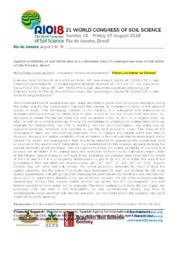Spatial variability of soil attributes in a cultivated area of underground dam in the State of the Paraíba, Brazil.
Spatial variability of soil attributes in a cultivated area of underground dam in the State of the Paraíba, Brazil.
Author(s): SILVA, M. S. L. da; NASCIMENTO, A. F. do; SILVEIRA, H. L. F. da
Summary: The implementation of several municipal, state, and federal government programs aiming to facing the water scarcity has substantially improved the number of underground dams in the semiarid region of Brazil. That technology consists in the building of a waterproof wall transversal to drainage water preventing the lateral flow of water in and on the soil, stream bed, and River. So, the water is stored into the soil pores and may be used to crops ?in situ? or to irrigate areas ?ex situ?, as well as to animal watering. Among the advantages in adopting the underground dams we highlight the functionality, low cost to building, low risk of contamination, low water loss by evapotranspiration, moreover it is possible to use the land around to crops. The areas of the underground dams are disturbed environments once it changes the natural water flow and its dynamic. Knowing the spatial variability of soil attributes in this colluvial/alluvial areas would aid to choose the better soil management that should be adopted to guarantee the sustainable food production in this environment. Geostatistic is a powerful tool for this purpose, allowing showing the special variability of soil attributes. This work aimed to assess the spatial variability of chemical and physical soil attributes of an underground dam located in Solânea county, Curimataú region, state of the Paraíba, semiarid area in northeast Brazil. Disturbed soil samples were collected from depth of 0-0.2 m and 0.2-0.4 m of 16 points distributed in a grid of 25 m x 30 m within the area of the underground dam. Soil attributes assessed were: pH, Ca2+, Mg2+, K+, Na+, Al3+, H+, P2O5, Organic Carbon, clay, silt, sand, and bulk density. The model applied to elaborate the maps to show the spatial variability was the Spline. The whole maps elaborated for each soil attribute did not show spatial dependence, indicating that even changing the environment by building a wall into the soil, there were no significantly disturbs in the soil attributes. Actually, the soil of the underground dam showed high fertility, high organic matter content, low acidity and Al3+ exchangeable, and with texture suitable to store water and to cropping. Therefore, underground dams did not trigger soil processes that can lead to soil degradation, as ions accumulation, acidity, low level of exchangeable bases, and high bulk density, however, we have realized just the opposite, very good condition to plants growing.
Publication year: 2018
Types of publication: Abstract in annals or event proceedings
Unit: Embrapa Territorial
Observation
Some of Embrapa's publications are published as ePub files. To read them, use or download one of the following free software options to your computer or mobile device. Android: Google Play Books; IOS: iBooks; Windows and Linux: Calibre.
Access other publications
Access the Agricultural Research Database (BDPA) to consult Embrapa's full library collection and records.
Visit Embrapa Bookstore to purchase books and other publications sold by Embrapa.

